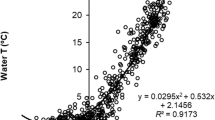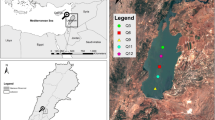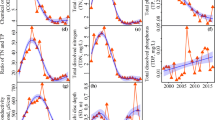Abstract
We assessed long-term impacts of multiple stressors and their interaction on the zooplankton community of the large, eutrophic, cyanobacteria-dominated Lake Peipsi (Estonia, Russia). Stressor dataset consisted in time series (1997–2018) of temperature, nutrients, pH, water transparency, phytoplankton biomass and taxonomic richness. The best predictors were selected with random forests machine-learning algorithms and the subsequent models were constructed with generalized linear modeling. We also aimed to identify graphical thresholds representing non-linear, marked responses of abundance or biomass to stressors. Temperature was the dominant stressor for explaining zooplankton abundance and biomass, followed by cyanobacteria biomass, total nitrogen concentration and water transparency. The effect of water temperature was positive, whereas the effect of cyanobacteria became negative after their biomass exceeded a threshold of ~ 2 mg l−1. However, the two stressors together had antagonistic effects on zooplankton, causing a decrease in biomass and abundance. For zooplankton, critical thresholds of total nitrogen (~ 700 μg l−1), total phosphorus (~ 70 μg l−1), and water transparency (~ 1.4 m) after which zooplankton metrics changed drastically, were determined. These findings show that although lake warming alone could be positive for zooplankton, the necessity of reducing interacting stressors that influence harmful cyanobacteria growth and biomass, especially nitrogen loads, must be considered.






Similar content being viewed by others
Data availability
Data availability provided by the authors on request.
Code availability
Code availability provided by the authors on request.
References
Agasild, H., K. Panksep, I. Tõnno, K. Blank, T. Kõiv, R. Freiberg, R. Laugaste, R. I. Jones et al., 2019. Role of potentially toxic cyanobacteria in crustacean zooplankton diet in a eutrophic lake. Harmful Algae 89: 101688.
Akaike, H., 1973. Information theory and an extension of the maximum likelihood principle. In Petrov, B. N. (ed.), Proceedings of the Second International Symposium on Information Theory. Akademiai Kiado, Budapest: 267–281.
Arfè, A., P. Quatto, A. Zambon, H. J. MacIsaac & M. Manca, 2019. Long-term changes in the zooplankton community of Lake Maggiore in response to multiple stressors: a functional principal components analysis. Water 11: 962.
Balushkina, E. V. & G. G. Winberg, 1979. Relation between body mass and length in case of plankton animals. In Winberg, G. G. (ed.), Headlines of Water Ecosystem Research. Nauka, Leningrad: 169–172 (in Russian).
Battarbee, R. W., N. J. Anderson, H. Bennion & G. L. Simpson, 2012. Combining limnological and palaeolimnological data to disentangle the effects of nutrient pollution and climate change on lake ecosystems: problems and potential. Freshwater Biology 57: 2091–2106.
Birk, S., D. Chapman, L. Carvalho, B. M. Spears, H. E. Andersen, C. Argillier, S. Auer, A. Baattrup-Pedersen et al., 2020. Impacts of multiple stressors on freshwater biota across spatial scales and ecosystems. Nature Ecology & Evolution 4: 1060–1068.
Brucet, S., D. Boix, X. D. Quintana, E. Jensen, L. W. Nathansen, C. Trochine, M. Meerhoff, S. Gascón et al., 2010. Factors influencing zooplankton size structure at contrasting temperatures in coastal shallow lakes: implications for effects of climate change. Limnology and Oceanography 55: 1697–1711.
Côté, I. M., E. S. Darling & C. J. Brown, 2016. Interactions among ecosystem stressors and their importance in conservation. Proceedings of the Royal Society B: Biological Sciences 283: 20152592.
Cremona, F., A. Järvalt, U. Bhele, H. Timm, S. Seller, J. Haberman, P. Zingel, H. Agasild, P. Nõges & T. Nõges, 2018. Relationships between fisheries, foodweb structure, and detrital pathway in a large shallow lake. Hydrobiologia 820: 145−163.
Cremona, F., H. Agasild, J. Haberman, P. Zingel, P. Nõges, T. Nõges & A. Laas, 2020. How warming and other stressors affect zooplankton abundance, biomass and community composition in shallow eutrophic lakes. Climatic Change 159: 565−580.
Davis, P. & G. W. Ozburn, 1969. The pH tolerance of Daphnia pulex (Leydig). Canadian Journal of Zoology 47: 1173−1175.
de Senerpont Domis, L. N., J. J. Elser, A. S. Gsell, V. M. Huszar, B. W. Ibelings, E. Jeppesen, S. Kosten, W. M. Mooij et al., 2013. Plankton dynamics under different climatic conditions in space and time. Freshwater Biology 58: 463–482.
EN 15204: 2006. Water quality—guidance standard for routine analysis of phytoplankton abundance and composition using inverted microscopy (Utermöhl technique). https://www.evs.ee/et/evs-en-15204-2006.
Escribano, R., P. Hidalgo, V. Valdés & L. Frederick, 2014. Temperature effects on development and reproduction of copepods in the humboldt current: the advantage of rapid growth. Journal of Plankton Research 36: 104–116.
Estlander, S., L. Nurminen, M. Olin, M. Vinni & J. Horppila, 2009. Seasonal fluctuations in macrophyte cover and water transparency of four brown-water lakes: implications for crustacean zooplankton in littoral and pelagic habitats. Hydrobiologia 620: 109–120.
Feld, C. K., P. Segurado & T. Gutiérrez-Canovas, 2016. Analysing the impact of multiple stressors in aquatic biomonitoring data: a “cookbook” with applications in R. Science of the Total Environment 573: 1320–1339.
Folt, C. L., C. Y. Chen, M. V. Moore & J. Burnaford, 1999. Synergism and antagonism among multiple stressors. Limnology and oceanography 44: 864–877.
Fulton, R. S., 1988. Grazing on filamentous algae by herbivorous zooplankton. Freshwater Biology 20: 263–271.
Fulton, R. S. & H. W. Paerl, 1987. Effects of colonial morphology on zooplankton utilization of algal resources during blue-green algal (Microcystis aeruginosa) blooms. Limnology and Oceanography 32: 634–644.
Gannon, J. E. & R. S. Stemberger, 1978. Zooplankton (especially crustaceans and rotifers) as indicators of water quality. Transactions of the American Microscopical Society 97: 16–35.
Ger, K. A., L.-A. Hansson & M. Lürling, 2014. Understanding cyanobacteria‐zooplankton interactions in a more eutrophic world. Freshwater Biology 59: 1783–1798.
Ger, K. A., E. J. Faassen, M. G. Pennino & M. Lürling, 2016. Effect of the toxin (microcystin) content of Microcystis on copepod grazing. Harmful Algae 52: 34–45.
Ghadouani, A., B. Pinel‐Alloul & E. E. Prepas, 2003. Effects of experimentally induced cyanobacterial blooms on crustacean zooplankton communities. Freshwater Biology 48: 363–381.
Gillooly, J. F. & S. I. Dodson, 2000. Latitudinal patterns in the size distribution and seasonal dynamics of new world, freshwater cladocerans. Limnology and Oceanography 45: 22–30.
Haberman, J., 1977. Scales of domination, frequency of occurrence and weights of zooplankters. In Dombrovsky, V. K., P. I. Zhukov, V. P. Lyahnovich, A. P. Ostapenya, P. G. Petrovich, L. M. Sushchenya & S. S. Fokina (eds), 19th Scientific Conference of the Baltic States and Byelorussia on the Research of Waterbodies. EPPP BelNIINTI, Minsk: 153–154 (in Russian).
Haberman, J. & M. Haldna, 2017. How are spring zooplankton and autumn zooplankton influenced by water temperature in a polymictic lake? The Proceedings of the Estonian Academy of Sciences 66: 264–278.
Haberman, J., M. Haldna, R. Laugaste & K. Blank, 2010. Recent changes in large and shallow Lake Peipsi (Estonia/Russia): causes and consequences. Polish Journal of Ecology 58: 645–662.
Hart, R. C., 1988. Zooplankton feeding rates in relation to suspended sediment content: potential influences on community structure in a turbid reservoir. Freshwater Biology 19: 123–139.
Ishwaran, H. & U. Kogalur, 2020. Fast unified random forests for survival, regression, and classification (RF-SRC). R package version 2.9.3, https://cran.r-project.org/package=randomForestSRC.
Jaani, A., 2001. The location, size and general characterization of Lake Peipsi and its catchment area. In Nõges, T. (ed), Lake Peipsi: Meteorology, Hydrology, Hydrochemistry. Sulemees, Tartu: 10–17.
Jaani, A., L. Klaus, O. Pärn, U. Raudsepp, O. Zadonskaja, T. Gronskaja & V. Solntsev, 2008. Hüdroloogia. In Haberman, J., T. Timm & A. Raukas (eds), Peipsi. Eesti Loodusfoto, Tartu: 113–155 (in Estonian).
Jacobson, P. C., G. J. A. Hansen, B. J. Bethke & T. K. Cross, 2017. Disentangling the effects of a century of eutrophication and climate warming on fresh water lake fish assemblages. PLoS One 12: e0182667.
James, G., D. Witten, T. Hastie & R. Tibshirani, 2017. An Introduction to Statistical Learning: With Applications in R (1st ed. 2013, Corr. 7th printing 2017 edition). Springer, New York.
Jamet, J. L., 1994. Feeding activity of adult roach (Rutilus rutilus (L.)), perch (Perca fluviatilis L.) and ruffe (Gymnocephalus cernuus (L.)) in eutrophic Lake Aydat (France). Aquatic Sciences 56: 376–387.
Jeppesen, E., P. Nõges, T. A. Davidson, J. Haberman, T. Nõges, K. Blank, T. L. Lauridsen, M. Søndergaard et al., 2011. Zooplankton as indicators in lakes: a scientific-based plea for including zooplankton in the ecological quality assessment of lakes according to the European Water Framework Directive (WFD). Hydrobiologia 676: 279–297.
Jeppesen, E., M. Meerhoff, T. A. Davidson, D. Trolle, M. Søndergaard, T. L. Lauridsen, M. Beklioglu, S. B. Balmaña et al., 2014. Climate change impacts on lakes: an integrated ecological perspective based on a multi-faceted approach, with special focus on shallow lakes. Journal of Limnology 73: 84–107.
Jiang, X., W. Yang, X. Xiang, Y. Niu, L. Chen & J. Zhang, 2014. Cyanobacteria alter competitive outcomes between Daphnia and Bosmina in dependence on environmental conditions. Fundamental and Applied Limnology 184: 11–22.
Jiang, X., J. Xie, Y. Xu, W. Zhong, X. Zhu & C. Zhu, 2017. Increasing dominance of small zooplankton with toxic cyanobacteria. Freshwater Biology 62: 429–443.
Kangur, K. & T. Möls, 2008. Changes in spatial distribution of phosphorus and nitrogen in the large north-temperate lowland Lake Peipsi (Estonia/Russia). Hydrobiologia 599: 31–39.
Kiselev, J. A., 1956. Methods of plankton research. In Pavlovski, E. N. & V. I. Zhadin (eds), Freshwater Biota of the USSR IV. Izdatelstvo AN SSSR, Moscow-Leningrad: 183–265 (in Russian).
Kohn, N. P., J. Q. Word, D. K. Niyogi, T. Dillon & D. W. Moore, 1994. Acute toxicity of ammonia to four species of marine amphipod. Marine Environmental Research 38: 1−15.
Laugaste, R., P. Nõges, T. Nõges, V. V. Yastremskij, A. Milius & I. Ott, 2001. Algae. In Pihu, E. & J. Haberman (eds), Lake Peipsi: Flora and Fauna. Sulemees, Tartu: 31−49.
Laugaste, R., K. Panksep & M. Haldna, 2013. Dominant cyanobacterial genera in Lake Peipsi (Estonia/Russia): effect of weather and nutrients in summer months. Estonian Journal of Ecology 62: 229–243.
Mack, L., H. E. Andersen, M. Beklioglu, T. Bucak, R. M. Couture, F. Cremona, M. T. Ferreira, M. G. Hutchins et al., 2019. The future depends on what we do today—projecting Europe's surface water quality into three different future scenarios. Science of the Total Environment 668: 470–484.
Maclennan, M. M., C. Dings-Avery & R. D. Vinebrooke, 2015. Invasive trout increase the climatic sensitivity of zooplankton communities in naturally fishless lakes. Freshwater Biology 60: 1502–1513.
Mantzouki, E., M. Lürling, J. Fastner, L. de Senerpont Domis, E. Wilk-Woźniak, J. Koreiviene, L. Seelen, S. Teurlincx et al., 2018. Temperature effects explain continental scale distribution of cyanobacterial toxins. Toxins 10: 156.
Mitchell, S. A., 1992. The effect of pH on Brachionus calyciflorus Pallas (Rotifera). Hydrobiologia 245: 87–93.
Mooij, W. M., J. H. Janse, L. N. de Senerpont Domis, S. Hülsmann & B. W. Ibelings, 2007. Predicting the effect of climate change on temperate shallow lakes with the ecosystem model PCLake. Hydrobiologia 584: 443–454.
Moss, B., S. Kosten, M. Meerhoff, R. W. Battarbee, E. Jeppesen, N. Mazzeo, K. Havens, G. Lacerot et al., 2011. Allied attack: climate change and eutrophication. Inland Waters 1: 101–105.
Nõges, T., H. Agasild, J. Haberman, A. Kangur, K. Kangur, P. Kangur, H. Timm, P. Zingel & P. Nõges, 2004. Food webs in Lake Võrtsjärv. In Haberman J., E. Pihu & A. Raukas (eds), Lake Võrtsjärv. Estonian Encyclopedia Publishers, Tallinn: 335–345.
Ormerod, S. J., M. Dobson, A. G. Hildrew & C. Townsend, 2010. Multiple stressors in freshwater ecosystems. Freshwater Biology 55: 1–4.
Öğlü, B., T. Möls, T. Kaart, F. Cremona & K. Kangur, 2020. Parameterization of surface water temperature and long-term trends in Europe’s fourth largest lake shows recent and rapid warming in winter. Limnologica 82: 125777.
Özen, A., M. Šorf, C. Trochine, L. Liboriussen, M. Beklioglu, M. Søndergaard, T. L. Lauridsen, L. S. Johansson et al., 2013. Long term effects of warming and nutrients on microbes and other plankton in mesocosms. Freshwater Biology 58: 483–493.
Pahlow, M. & A. F. Prowe, 2010. Model of optimal current feeding in zooplankton. Marine Ecology Progress Series 403: 129–144.
Peltomaa, E. T., S. L. Aalto, K. M. Vuorio & S. J. Taipale, 2017. The Importance of Phytoplankton Biomolecule Availability for Secondary Production. Frontiers of Ecology and Evolution 5: 128.
Piggott, J. J., C. R. Townsend & C. D. Matthaei, 2015. Reconceptualizing synergism and antagonism among multiple stressors. Ecology and Evolution 5: 1538–1547.
Qian, S. S., 2017. Environmental and Ecological Statistics with R, second edition. Chapman and Hall/CRC.
Rasconi, S., A. Gall, K. Winter & M. J. Kainz, 2015. Increasing water temperature triggers dominance of small freshwater plankton. PloS One 10: e0140449.
R Core Team, 2020. R: a language and environment for statistical computing. R Foundation for Statistical Computing. URL, Austria, Vienna https://www.R-project.org. Accessed November 2020.
Ruttner-Kolishko, A., 1977. Suggestions for biomass calculation of planktonic rotifers. Archiv fur Hydrobiologie 8: 71–76.
Shurin, J. B., N. Winder, R. Adrian, W. Keller, B. Matthews, A. M. Paterson, M. J. Paterson, B. Pinel-Alloul et al., 2010. Environmental stability and lake zooplankton diversity – contrasting effects of chemical and thermal variability. Ecology Letters 13: 453–463.
Sikora, A. & P. Dawidowicz, 2014. Do the presence of filamentous cyanobacteria and an elevated temperature favor small-bodied Daphnia in interspecific competitive interactions? Fundamental and Applied Limnology/Archiv für Hydrobiologie 185: 307–314.
Sinclair, J. S. & S. E. Arnott, 2015. Effects of an invasive consumer on zooplankton communities are unaltered by nutrient inputs. Freshwater Biology 60: 161–173.
Smol, J. P., 2016. Arctic and Sub-Arctic shallow lakes in a multiple-stressor world: a paleoecological perspective. Hydrobiologia 778: 253–272.
Straile, D., 2015. Zooplankton biomass dynamics in oligotrophic versus eutrophic conditions: a test of the PEG model. Freshwater Biology 60: 174–183.
Straile, D., R. Adrian, D.E. Schindler. 2012. Uniform temperature dependency in the pof a keystone herbivore in lakes of the northern hemisphere. PloS One 7: e45497.
Studenikina, E. I. & M. M. Cherepahina, 1969. Mean weight of basic zooplankton forms of the Azov Sea. Gidrobiologia Zurnal 5: 89–91 (in Russian).
Tammeorg, O., J. Horppila, P. Tammeorg, M. Haldna & J. Niemistö, 2016. Internal phosphorus loading across a cascade of three eutrophic basins: A synthesis of short-and long-term studies. Science of the Total Environment 572: 943−954.
Tõnno, I., K. Nauts, S. Belle, M. Nõmm, R. Freiberg, T. Kõiv & T. Alliksaar, 2019. Holocene shifts in the primary producer community of large, shallow European Lake Peipsi, inferred from sediment pigment analysis. Journal of Paleolimnology 61: 403−417.
Utermöhl, H., 1958. Zur Vervollkommnung der quantitativen Phytoplankton Methodik. International Association of Theoretical Limnology 9: 1–38 (in German).
Virro, T., J. Haberman, M. Haldna & K. Blank, 2009. Diversity and structure of the winter rotifer assemblage in a shallow eutrophic northern temperate Lake Võrtsjärv. Aquatic Ecology 43: 755–764.
Yang, J., X. Zhang, Y. Xie, C. Song, J. Sun, Y. Zhang, J. P. Giesy & H. Yu, 2017. Ecogenomics of zooplanton community reveals ecological threshold of ammonia nitrogen. Environmental Science & Technology 51: 3057–3064.
Acknowledgements
We are grateful to Tartu Environmental Research Ltd (Estonia) for water chemistry data. This research was financed by Estonian Research Council Grant PSG 32 to FC. Data collection within the frames of the state monitoring programme were supported by the Estonian Ministry of the Environment.
Funding
Funding was provided by Estonian Research Council PSG32.
Author information
Authors and Affiliations
Contributions
All authors contributed equally to the research.
Corresponding author
Ethics declarations
Conflict of interest
The authors declare that they have no conflict of interest.
Additional information
Handling editor: Andrew Dzialowski
Publisher's Note
Springer Nature remains neutral with regard to jurisdictional claims in published maps and institutional affiliations.
Rights and permissions
About this article
Cite this article
Cremona, F., Blank, K. & Haberman, J. Effects of environmental stressors and their interactions on zooplankton biomass and abundance in a large eutrophic lake. Hydrobiologia 848, 4401–4418 (2021). https://doi.org/10.1007/s10750-021-04653-3
Received:
Revised:
Accepted:
Published:
Issue Date:
DOI: https://doi.org/10.1007/s10750-021-04653-3




